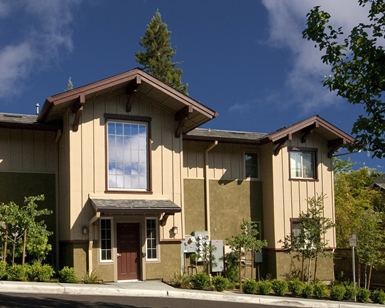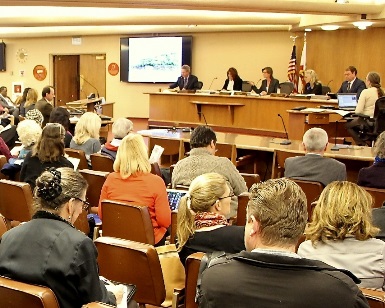This feature story is the second in a series that highlights the top priorities set by Marin County Board of Supervisors, based on input from Marin residents. The Deeper Dive series provides perspective and vision about important local issues.
San Rafael, CA – Marin County’s stunning natural beauty, proximity to San Francisco and the majestic Pacific coastline make it a highly desirable place to be and live. However, rising rents and home prices are making it difficult for many to keep living in Marin.
 Toussin Place in Kentfield is an affordable housing complex for seniors.
Toussin Place in Kentfield is an affordable housing complex for seniors.
The
Marin County Community Development Agency, charged with overseeing the affordable housing program for unincorporated areas of Marin, often shares statistics about housing in our communities. The median single-family, detached home costs about $1 million, requiring an annual household income of almost $200,000 to afford average mortgage payments. The average two-bedroom apartment rent is more than $2,500 per month.
As the Marin County Board of Supervisors has heard during a series of public workshops over the past few years – often in the form of emotional personal accounts – much of Marin’s workforce can’t afford those costs and as a result commute from nearby counties. The lack of affordable housing hampers employee recruitment for local businesses, government agencies, school districts and nonprofits. Talented job prospects often pass up Marin offers and accept positions in locations closer to where they can afford to live.
Those outside of Marin might respond by saying, “So why don’t you just build more housing?” Inside Marin, we know it’s not that simple. About 80 percent of the county remains undeveloped because of longstanding commitments by local, state and federal officials to support the preservation of open space. Without much chance to create new affordable housing, the focus is on saving what remains of existing affordable housing and getting creative on affordable housing options, such as second units on local properties.
Supervisor Steve Kinsey, the Board President this year, said preserving affordable housing ties in with the mission of the County of Marin government: to provide excellent services that support healthy, safe and sustainable communities; preserve Marin's unique environmental heritage; and encourage meaningful participation in the governance of the County by all.
“Not only is it the right thing to do in a moral sense, but practically speaking it adds to the quality of life for everybody by welcoming a diverse population that accurately reflects our changing demographics,” Kinsey said. “Having more affordable housing options reduces congestion on our roads and addresses income inequality.”
Commitment to Preserve Affordable Homes
Housing prices in Marin are at an all-time high, vacancy rates are at historic lows, and more residents are qualifying for affordable housing. For those reasons, the Board is committed to preserving existing affordable housing and ensuring that affordable homes are integrated into all areas of the county to provide a more diverse and healthy community.
The following new initiatives, endorsed by the Board in February 2016, support those goals:
- Purchase existing housing to preserve economic diversity
- Work with landlords to keep rents affordable
- Provide incentives for affordable second units
- Protect low-income renters from housing discrimination
- Renew an amnesty program for second units
To support the commitment, the Board recently approved a $1 million contribution to its Affordable Housing Trust Fund as it approved the final 2016-17 County budget. The move, which brought the balance of that fund to about $6 million, was designed to preserve and increase the supply of rental housing for families and to support new housing consistent with the Countywide Plan. The Board also devoted $450,000 to a new innovative landlord incentive program, set to launch later this summer, to earmark rentals for those who qualify for affordable housing.
“The state and federal governments have created guidelines but have not stepped up in contributing financially to help us accomplish the goals that have been set,” Kinsey said. “We’re limited on how much we can do, but we’re going to do the best we can because it’s the right thing to do.”
The Board established the Housing Trust Fund in 1980 as a way to establish financial support for new affordable houses projects. The trust provides a local funding source for financial and technical assistance to help affordable housing developers create and preserve affordable housing for low-income and very-low-income households ($88,650 to $55,350 for a family of three). Recently, the Trust Fund has been used to fund preservation of existing housing.
 The County has held dozens of public workshops and discussions the past few years to hear thoughts and ideas from residents about ways to make Marin County more affordable.
The County has held dozens of public workshops and discussions the past few years to hear thoughts and ideas from residents about ways to make Marin County more affordable.
Recent Progress on Preserving Housing
Three acquisitions have utilized the Housing Trust Fund over the past seven months. On June 14, the Board approved a grant and loan totaling $1 million from the housing trust to acquire a Stinson Beach apartment building with the goal of preserving it and providing eight affordable homes in perpetuity. Stinson Beach has an urgent and acute need for affordable housing, made even more challenging because of a severe shortage of developable land. When high home prices and high rents in the ocean-view areas are combined with a tourism-based economy and relatively low-wage hospitality and maintenance jobs, the need for affordable housing becomes critical. Additional funding came from a grant and loan from Marin Community Foundation and donations from local community members.
In February 2016, $675,000 from the Housing Trust Fund was used for a loan for the purchase of the Piper Court Apartment in Fairfax. Twenty-seven homes on Piper Court were in danger of being switched from moderate income to market-rate income; the County’s move preserved all 27 homes as affordable housing.
In November 2015 the Supervisors approved funding toward the purchase of a 20-space trailer court in Forest Knolls by a local nonprofit housing provider. The $617,000 loan was used to preserve the property as affordable community housing in perpetuity and fund needed repairs and upgrades.
“Over the past two years we’ve made significant movement with our strategies and have spent that trust money wisely,” Kinsey said. “We’re establishing a track record of success with it. We’re looking forward to finding other opportunities to put those funds to good use and welcome new ideas from the community to preserve existing units.”
More Residents Qualify for Affordable Housing
Because of the high average incomes in Marin, more and more of the local workforce qualifies for affordable housing. Census data from 2014 shows a median household income of $85,070 for Marin, and the projected median for 2016 is $94,549. Regardless of the specific numbers, Marin is consistently among the top 20 counties in the United States in this category.
A household that falls into the low-income category is considered to be 80 percent of Area Median Income. In Marin, a family that earns $88,650 annually falls into that category. Most affordable housing in Marin serves households at 60 percent of the Area Median Income, or $58,170 per year. Outsiders might think that’s a lot of money, but it doesn’t go very far in one of the most expensive places to live in the country.
Census data shows that 53.2 percent of Marin households earn less than $100,000 per year and 29.2 percent bring in less than $50,000 a year. Meanwhile, the County’s Community Development Agency notes that it takes more than $108,000 annually per household to afford a typical apartment rent in Marin. That translates to more than half of Marin’s existing residents struggling to make ends meet.
All sorts of steadily employed people qualify for affordable housing in Marin. Store clerks, health care workers, gardeners, teachers, restaurant wait staff, child care workers, nonprofit employees and young professionals are just some of the workforce members who can be eligible for below-market-rate homes. However, there is not an adequate supply of affordable workforce housing in Marin to meet the need; less than 4 percent of all housing in unincorporated Marin is reserved for low- or moderate-income residents. Seniors on fixed incomes, families with children and young adults, including many who have lived in Marin all their lives, are being priced out.
“We’re losing members of our community to our own housing market, and that doesn’t sit well with us,” Kinsey said. “We’ve spent a lot of time listening to our residents on this subject and had our CDA staff do tons of research on it. We believe the result is a preservation strategy that allows us a much better chance to keep our current residents here.”